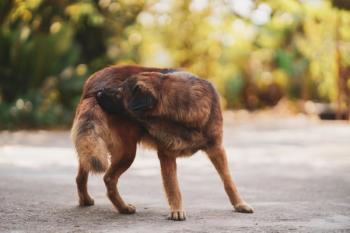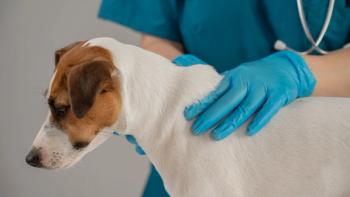
How to love and care for cocker spaniel ears (Proceedings)
Cocker spaniels have higher yeast carriage in the ear and it may be easier for the yeast to cause disease.
I. Popularity
II. Reaction to treatment
III. Gross anatomy
a. Pendulous
i. Aerate and examine ears
b. Heavily haired
i. Keep hair trimmed as short as possible
IV. Microscopic Anatomy
a. Significantly more ceruminous glands
i. Use ceruminolytic and drying agents regularly
b. High density compound hair follicles
i. Grooming
II. No powders
III. Use anti-inflammatories after pulling hair
V. Atopy
a. Treat systemically
b. Use acidifying/drying agents on a regular basis
c. Use topical steroids
VI. Seborrhea and Hypothyroidism
a. Treat underlying disease
b. Vitamin A: 600 to 800 IU/kg/day
c. Levothyroxine
d. Ceruminolytic agents
e. Topical steroids
VII. Malassezia
a. Cockers produce more cerumen with higher fatty acid content
b. Malassezia attach to corneocytes via lipid
c. Therefore Cockers have higher yeast carriage in the ear and it may be easier for the yeast to cause disease.
d. Treatment
i. Ceruminolytic agents
II. Topical steroids
III. Drying/acidifying agents
IV. Topical antifungals
1. Ketoconazole (T8 Keto Flush®), Clotrimazole, Miconazole (Conofite®, Malaseb® flush)
v. Systemic antifungals
1. Ketoconazole (5-10 mg/kg daily)
2. Itraconazole (5 mg/kg daily or 2 days a week)
3. Fluconazole (5 mg/kg daily)
VIII. Exuberant Reaction to Inflammation
a. In most studies, Cockers far outnumber any other breed that needs surgical removal of the ears.
b. Cockers have a different type of tissue reaction to otic inflammation.
i. Most dogs breeds have slowly progressive fibrotic changes
II. Cockers have rapidly progressive, severe ceruminous gland hyperplasia
c. Must treat aggressively
i. Prednisone
1. 2.2 mg/kg divided BID for at least 3 to 14 days then decreasing over time.
II. Topical steroids
1. Fluocinolone (Synotic®)
IX. Otitis Media
a. In one large study 42% of the dogs with otitis media were Cockers.
b. The exuberant inflammation in the outer canal causes inflammation in the tympanic bulla.
i. This leads to a decrease in the normal ciliary cells of the middle ear lining and an increase in the goblet cells which form mucin glands.
ii. The mucin formed by theses altered glands can form polymer chains and is much more viscous than normal middle ear fluid.
c. The exuberant inflammation in the outer canal causes a loss or reversal of epidermal migration. This can result in:
i. Rupture of the tympanic membrane
II. Formation of cholesteatomas
d. Diagnosis
i. Radiology
1. In end stage ears plain radiographs miss at least 25 to 33% of histopathologically confirmed otitis media.
2. This percentage is even higher when non-end stage ears are examined
3. CT and MRI are better than plain radiographs
4. Ultrasound is not as good as plain radiographs
II. Deep ear cleaning
1. Should be delayed until the inflammation has been decreased and the canal is open.
2. Assessment of the tympanic membrane
a. Visualization
b. Disappearance of tube
c. Excessive use of fluid
d. Patient swallowing during flushing
e. Curette catching on bony prominence
III. Myringotomy
1. When to do
a. Otitis greater than 3 months duration
b. Bulging or cloudy tympanic membrane
c. Fluid or debris behind the tympanic membrane
2. Where to perform
a. In the caudal ventral quadrant of the tympanum
IV. Assessment of tympanic bulla
1. Normally has sheen like a joint synovium and feels like bone.
2. Check for granulation tissue formation.
3. Cholesteatoma formation.
v. Hazards of deep ear cleaning and myringotomy
1. Horner's syndrome
2. Vestibular/ auditory dysfunction
3. Contact allergic reactions
4. Introduction of pathogens into the middle ear
e. Treatment
i. Aggressive and complete
II. Culture both external and middle ears when
1. Rods on cytology
2. Failure to respond to therapy
3. Greater than 3 months duration of disease
4. Value of culturing is debated
III. Pseudomonas culture/sensitivity
1. In a recent study polymyxin B(100%), gentamicin (85%) and enrofloxacin (62%) were the best antibiotic choices for Pseudomonas.
2. Kirby Bauer vs. MIC
a. Some Pseudomonas resistant to enrofloxacin on Kirby Bauer were sensitive on MIC
b. On Kirby Bauer, need to have individual discs for ciprofloxacin, enrofloxacin, and marbofloxacin
IV. Antibiotic Therapy
1. Incorporates both systemic and topical therapy
2. At home flushing is a vital part of therapy
3. Multi-drug therapy is recommended for Pseudomonas
a. Use antibiotics that have different routes of uptake and different mechanisms of action so that development of resistance is more difficult.
4. Topical therapy
a. T8® solution (tris-EDTA), let sit in ear 10-15 minutes, then put in antibiotic solution
b. Tris-EDTA increases penetration of antibiotics through Pseudomonas cell wall
c. Neomycin/polymyxin B/hydrocortisone
d. Gentamicin
e. Baytril/ dexamethasone/ saline (4cc, 1cc, 5cc)
5. Systemic therapy
a. Should be based on results of culture/sensitivity (if resistant to one of the fluoroquinolones, soon will be resistant to all)
b. Enrofloxacin (15-20 mg/kg daily)
c. Ciprofloxacin (12-22 mg/kg daily)
d. Marbofloxacin (5-7 mg/kg daily)
e. Prednisone as needed to open ear canal.
X. Maintenance Program
a. Owners usually cannot stop flushing completely.
b. Use a strong ceruminolytic and drying agent that is also acidic.
c. Long term topical steroid therapy may also be necessary.
Xi. Other Options
a. Cyclosporine
b. Retinoids
c. DMSO
d. Laser
Newsletter
From exam room tips to practice management insights, get trusted veterinary news delivered straight to your inbox—subscribe to dvm360.




